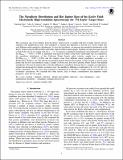The Metallicity Distribution and Hot Jupiter Rate of the Kepler Field: Hectochelle High-Resolution Spectroscopy for 776 Kepler Target Stars
Author(s)
Guo, Xueying; Johnson, John A.; Mann, Andrew W.; Kraus, Adam L.; Curtis, Jason L.; Latham, David W.; ... Show more Show less
DownloadGuo-2017-The Metallicity Distribution and Hot.pdf (2.387Mb)
PUBLISHER_POLICY
Publisher Policy
Article is made available in accordance with the publisher's policy and may be subject to US copyright law. Please refer to the publisher's site for terms of use.
Terms of use
Metadata
Show full item recordAbstract
The occurrence rate of hot Jupiters from the Kepler transit survey is roughly half that of radial velocity surveys targeting solar neighborhood stars. One hypothesis to explain this difference is that the two surveys target stars with different stellar metallicity distributions. To test this hypothesis, we measure the metallicity distribution of the Kepler targets using the Hectochelle multi-fiber, high-resolution spectrograph. Limiting our spectroscopic analysis to 610 dwarf stars in our sample with log g > 3.5, we measure a metallicity distribution characterized by a mean of [M/H][subscript mean] = -0.045±0.009, in agreement with previous studies of the Kepler field target stars. In comparison, the metallicity distribution of the California Planet Search radial velocity sample has a mean of [M/H][subscript CPS,mean] = -0.005±0.006, and the samples come from different parent populations according to a Kolmogorov–Smirnov test. We refit the exponential relation between the fraction of stars hosting a close-in giant planet and the host star metallicity using a sample of dwarf stars from the California Planet Search with updated metallicities. The best-fit relation tells us that the difference in metallicity between the two samples is insufficient to explain the discrepant hot Jupiter occurrence rates; the metallicity difference would need to be sime0.2–0.3 dex for perfect agreement. We also show that (sub)giant contamination in the Kepler sample cannot reconcile the two occurrence calculations. We conclude that other factors, such as binary contamination and imperfect stellar properties, must also be at play.
Date issued
2017-03Department
Massachusetts Institute of Technology. Department of Physics; MIT Kavli Institute for Astrophysics and Space ResearchJournal
Astrophysical Journal
Publisher
IOP Publishing
Citation
Guo, Xueying; Johnson, John A.; Mann, Andrew W.; Kraus, Adam L.; Curtis, Jason L. and Latham, David W. “The Metallicity Distribution and Hot Jupiter Rate of the Kepler Field: Hectochelle High-Resolution Spectroscopy for 776 Kepler Target Stars.” The Astrophysical Journal 838, no. 1 (March 2017): 25 © 2017 The American Astronomical Society
Version: Final published version
ISSN
1538-4357
0004-637X